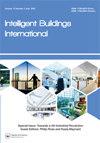Adaptive building envelope simulation in current design practice: findings from interviews with practitioners about their understanding of methods, tools and workarounds and implications for future tool developments
IF 1.7
Q2 CONSTRUCTION & BUILDING TECHNOLOGY
引用次数: 2
Abstract
ABSTRACT Adaptive building envelopes can dynamically adapt to environmental changes to improve thermal building performance. To predict the performance of design proposals with adaptive building envelopes, Building Performance Simulation (BPS) tools can be employed. However, one shortcoming of existing tools is their limited extensibility, which implies that accurately predicting adaptive building envelope performance remains a challenge and requires ad hoc approaches. This challenge has made practitioners reticent in considering adaptive building envelopes, which in turn has led to a slow uptake of them in the built environment. This study seeks to advance the understanding of the limitations of adaptive building envelope simulation in current design practice and to suggest implications for future tool developments. To this aim, the study adopts a user-centred perspective through interviews with experts in the field. Findings suggest that current BPS tools hinder the reliable prediction of adaptive building envelope performance, as accurately representing the level of detail of the building envelope is challenging. The subsequent workarounds applied are either time- and cost-intensive or do not consider the dynamic building envelope components. More flexible modelling approaches that allow for rapid prototyping and easy integration are required to enable designers to take full advantage of adaptive building envelopes.当前设计实践中的自适应建筑围护结构模拟:对从业者的采访结果,了解他们对方法、工具和解决方案的理解,以及对未来工具开发的影响
摘要自适应建筑围护结构可以动态适应环境变化,从而提高建筑的隔热性能。为了预测具有自适应建筑围护结构的设计方案的性能,可以使用建筑性能模拟(BPS)工具。然而,现有工具的一个缺点是其可扩展性有限,这意味着准确预测自适应建筑围护结构性能仍然是一个挑战,需要特别的方法。这一挑战使从业者在考虑自适应建筑围护结构时保持沉默,这反过来又导致它们在建筑环境中的应用缓慢。本研究旨在加深对自适应建筑围护结构模拟在当前设计实践中的局限性的理解,并对未来的工具开发提出建议。为此,该研究采用了以用户为中心的观点,通过采访该领域的专家。研究结果表明,当前的BPS工具阻碍了自适应建筑围护结构性能的可靠预测,因为准确地表示建筑围护结构的细节水平具有挑战性。随后应用的解决方案要么耗费大量时间和成本,要么不考虑动态建筑围护结构构件。为了使设计师能够充分利用自适应建筑围护结构,需要更灵活的建模方法来实现快速原型设计和简单集成。
本文章由计算机程序翻译,如有差异,请以英文原文为准。
求助全文
约1分钟内获得全文
求助全文
来源期刊

Intelligent Buildings International
CONSTRUCTION & BUILDING TECHNOLOGY-
CiteScore
4.60
自引率
4.30%
发文量
8
 求助内容:
求助内容: 应助结果提醒方式:
应助结果提醒方式:


